|
Peremennye Zvezdy (Variable Stars) 31, No. 1, 2011 Received 7 January; accepted 19 January.
|
Article in PDF |
GSC 2576-02071 and GSC 2576-01248: two Algol-type eclipsing binaries studied using CCD observations and historical photographic data
K. V. Sokolovsky1,2, S. V. Antipin3,4, A. V. Zharova3, S. A. Korotkiy5
- Max-Planck-Institute für Radioastronomie,
Auf dem Hügel 69, 53121 Bonn, Germany
- Astro Space Center of Lebedev Physical Institute,
Profsoyuznaya 84/32, 117997 Moscow, Russia
- Sternberg Astronomical Institute,
University Ave. 13, 119992 Moscow, Russia
- Institute of Astronomy,
Russian Academy of Sciences, Pyatnitskaya Str. 48, 119017 Moscow, Russia
- Ka-Dar Public Observatory, Barybino, Domodedovo District, Moscow Region, Russia
|
An initial investigation of two poorly studied
eclipsing binaries separated by
|
1. GSC 2576-01248: a short-period Algol-type binary with O'Connell effect
GSC 2576-01248 = T-CrB0-04444 = 2MASS 16113251+3306054
(16![]() 11
11![]() 32
32![]() 51 +33
51 +33![]() 06
06![]() 05
05
![]() 4, J2000; Skrutskie et
al. 2006) was discovered as an eclipsing binary by Devor et al.
(2008) during the Trans-atlantic Exoplanet Survey (TrES; Alonso et
al. 2004). It was also independently detected by the authors using
archival photographic data during initial tests of our digitized
photographic plate analysis pipeline (e.g., Sokolovsky 2006;
Kolesnikova et al. 2010). The digitized photographic plates were
originally obtained in 1973-1975 with the 40-cm astrograph of the
Crimean Laboratory of Sternberg Astronomical Institute (series
"A" of the Moscow plate collection, field
4, J2000; Skrutskie et
al. 2006) was discovered as an eclipsing binary by Devor et al.
(2008) during the Trans-atlantic Exoplanet Survey (TrES; Alonso et
al. 2004). It was also independently detected by the authors using
archival photographic data during initial tests of our digitized
photographic plate analysis pipeline (e.g., Sokolovsky 2006;
Kolesnikova et al. 2010). The digitized photographic plates were
originally obtained in 1973-1975 with the 40-cm astrograph of the
Crimean Laboratory of Sternberg Astronomical Institute (series
"A" of the Moscow plate collection, field ![]() CrB). To assess
the quality of the photographic photometry obtained with our
pipeline, in 2006 we have conducted V-band CCD observations of the
binary using the 50-cm Maksutov telescope (AZT-5) of the Crimean
Laboratory. The CCD observations were reduced in the standard way
involving dark-frame and flat-field corrections and aperture
photometry of the target star, the comparison (TYC 2576-2051-1,
V=10.76, Høg et al. 2000) and check stars in the field of view.
A typical accuracy of individual CCD photometric measurements is
CrB). To assess
the quality of the photographic photometry obtained with our
pipeline, in 2006 we have conducted V-band CCD observations of the
binary using the 50-cm Maksutov telescope (AZT-5) of the Crimean
Laboratory. The CCD observations were reduced in the standard way
involving dark-frame and flat-field corrections and aperture
photometry of the target star, the comparison (TYC 2576-2051-1,
V=10.76, Høg et al. 2000) and check stars in the field of view.
A typical accuracy of individual CCD photometric measurements is
![]() while the typical
accuracy of our photographic photometry for a
while the typical
accuracy of our photographic photometry for a
![]() -
-
![]() star was found to be
star was found to be
![]() .
.
Our series of CCD frames was checked for presence of other
variable objects in the field using the VaST software (Sokolovsky
and Lebedev 2005), which resulted in the discovery of another
eclipsing binary, GSC 2576-02071, just
![]() away (see the
following section). The effort to determine the period of the
newly discovered binary using observations with a number of
telescopes (Table 1) in 2006-2007 has resulted in a high-quality
lightcurve also for GSC 2576-01248 since both stars fit in the
same field of view for all the instruments used (Fig. 1).
away (see the
following section). The effort to determine the period of the
newly discovered binary using observations with a number of
telescopes (Table 1) in 2006-2007 has resulted in a high-quality
lightcurve also for GSC 2576-01248 since both stars fit in the
same field of view for all the instruments used (Fig. 1).
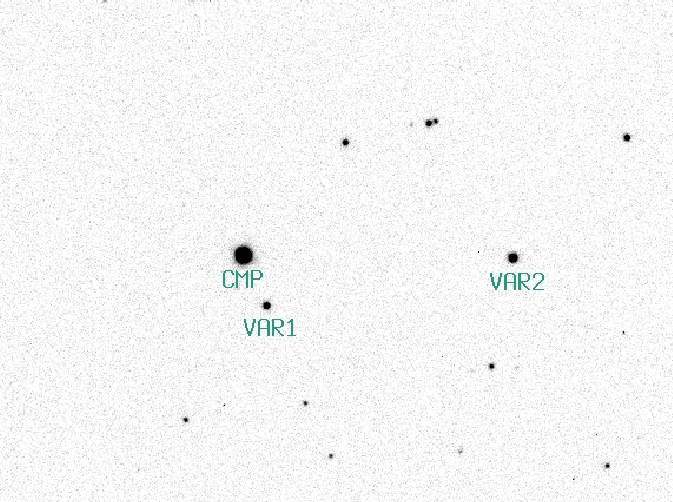 |
Fig. 1.
Finding chart for the
variable stars GSC 2576-01248 (marked VAR1), GSC 2576-02071
(VAR2), and the comparison star TYC 2576-2051-1 (CMP) made from
a |
Observations obtained with different instruments were combined
into a single lightcurve by shifting individual lightcurves to
match the average out-of-eclipse brightness to that observed with
AZT-5. The eclipse depth is the same for both ![]() -band and
unfiltered lightcurves (Fig. 2) thanks to the spectral response
curve of the blue-sensitive KAI-2020M CCD chip used in the
ST2000XM camera, which reaches its peak quantum efficiency in the
410-550 nm range around the
-band and
unfiltered lightcurves (Fig. 2) thanks to the spectral response
curve of the blue-sensitive KAI-2020M CCD chip used in the
ST2000XM camera, which reaches its peak quantum efficiency in the
410-550 nm range around the ![]() band.
band.
The combined lightcurve of GSC 2576-01248 was analyzed with the Lafler & Kinman (1965) method, which is well-suited for eclipsing binaries of the Algol type, such as the two variable stars presented in this paper. Fig. 3 shows the fine structure of the most significant peak on the Lafler & Kinman periodogram with and without the archival photographic data included in the analysis. Thanks to the large time baseline (photographic observations were obtained in 1973-1975 while the CCD observations were obtained in 2005-2007), the addition of less-precise photographic data to the high-accuracy CCD observations provides a significant improvement in the periodogram peak localization resulting in the following light elements:
The phased lightcurves folded with the above period are presented
in Fig. 4. The eclipses are partial and last for about 2 hours.
The primary eclipse is
![]() deep and the secondary eclipse is
deep and the secondary eclipse is
![]() deep in the
deep in the ![]() band.
band.
Fig. 5 shows the phased lightcurve for the two consecutive
observing seasons, 2006 and 2007. The presence of a prominent
(
![]() ) time-variable O'Connell effect
(O'Connell 1951, Davidge & Milone 1984) is evident from the plot.
The difference in maxima brightness (and eclipse depth) seems to
be caused by a wide dip, slowly travelling backwards through the
phased lightcurve. The effect may be explained by the presence of
a dark starspot on one of the binary system components that
rotates asynchronously (slightly slower) with respect to the
orbital motion.
) time-variable O'Connell effect
(O'Connell 1951, Davidge & Milone 1984) is evident from the plot.
The difference in maxima brightness (and eclipse depth) seems to
be caused by a wide dip, slowly travelling backwards through the
phased lightcurve. The effect may be explained by the presence of
a dark starspot on one of the binary system components that
rotates asynchronously (slightly slower) with respect to the
orbital motion.
Times of individual minima were measured from the CCD lightcurves
by applying the standard Kwee & van Woerden (1956) method. A
relatively large number of minima observed over the long time
baseline (Table 2) provides an opportunity to search for possible
period changes. From the ![]() plot (Fig. 6) it is evident that
the long-term behavior of the system is consistent with the
orbital period being the same in 1973-1975 and 2005-2007. The
estimated (also following Kwee & van Woerden 1956) errors of
minima time determination cannot account for the observed scatter
of measurements around
plot (Fig. 6) it is evident that
the long-term behavior of the system is consistent with the
orbital period being the same in 1973-1975 and 2005-2007. The
estimated (also following Kwee & van Woerden 1956) errors of
minima time determination cannot account for the observed scatter
of measurements around ![]() ; however, we note that these
error estimations should be treated with caution since they do not
account for any systematic difference in the shape of the
descending and ascending branches of the eclipse lightcurve (real
or caused by uncorrected systematic effects in photometry) or for
the sensitivity of the method to the exact choice of eclipse
boundaries, which needs to be set manually for the time of minimum
determination. For photographic observations, no time series were
recorded during eclipses. The few faintest data points on the
photographic lightcurve were taken as the best available minima
time estimates in that era. The total uncertainty of the
photographic times of minima determination was set to a typical
exposure time used for the plates (
; however, we note that these
error estimations should be treated with caution since they do not
account for any systematic difference in the shape of the
descending and ascending branches of the eclipse lightcurve (real
or caused by uncorrected systematic effects in photometry) or for
the sensitivity of the method to the exact choice of eclipse
boundaries, which needs to be set manually for the time of minimum
determination. For photographic observations, no time series were
recorded during eclipses. The few faintest data points on the
photographic lightcurve were taken as the best available minima
time estimates in that era. The total uncertainty of the
photographic times of minima determination was set to a typical
exposure time used for the plates (![]() min).
min).
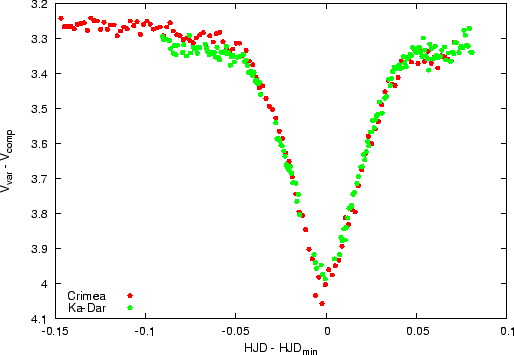 |
Fig. 2.
Two
primary minima of GSC 2576-01248 observed in Crimea (red) with
AZT-5 in |
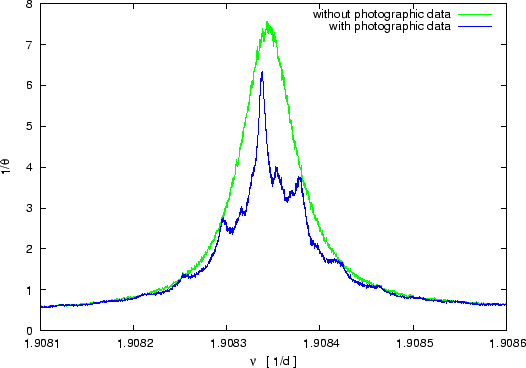 |
Fig. 3.
Periodogram of GSC
2576-01248 computed using the Lafler & Kinman (1965) method in a
narrow frequency range around the most significant peak. |
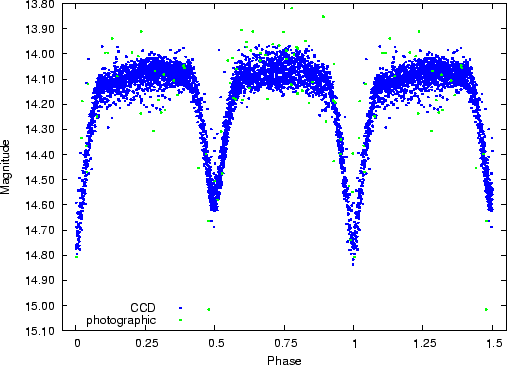 |
Fig. 4.
Lightcurve of GSC
2576-01248 combining CCD (blue) and photographic (green) data
phased with the following light elements:
|
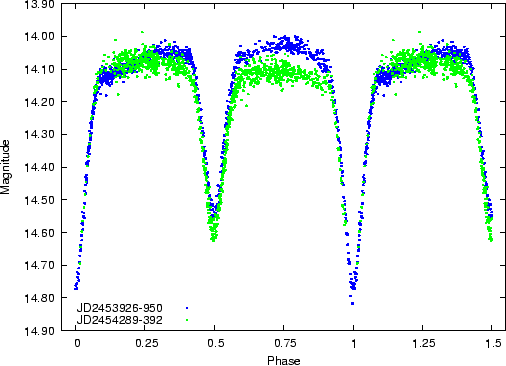 |
Fig. 5.
Lightcurve of
GSC 2576-01248 for the observing seasons 2006 (blue) and 2007
(green) folded with the light elements
|
| Observatory | Telescope | Aperture, cm | Filter | Detector |
| Crimea (SAI) | astrograph | 40 | none | photographic plate |
| AZT-5 | 50 | V | CCD Pictor 416XTE | |
| Zeiss-2 | 60 | V | CCD ST2000XM | |
| V | CCD Apogee 47P | |||
| Crimea (CrAO) | 24 | none | CCD ST2000XM | |
| Ka-Dar | Meade LX200-14
|
35 | none | CCD ST2000XM |
| Vixen | 10 | none | CCD ST2000XM | |
| TrES | see Alonso et al. 2004 | CCD | ||
SAI stands for the Sternberg Astronomical Institute's Crimean Laboratory, CrAO is the Crimean Astrophysical Observatory (Ukraine).
| HJD(TT) | Error (d) | Type | Telescope |
|
|
II | 40-cm (
|
|
| I | 40-cm (
|
||
| I | 40-cm (
|
||
| II | 40-cm (
|
||
| II | 40-cm (
|
||
| I | 40-cm (
|
||
| I | 40-cm (
|
||
| I | TrES | ||
| I | TrES | ||
| II | TrES | ||
| I | TrES | ||
| II | TrES | ||
| II | TrES | ||
| I | TrES | ||
| I | TrES | ||
| I | TrES | ||
| I | TrES | ||
| II | TrES | ||
| II | TrES | ||
| II | TrES | ||
| I | TrES | ||
| I | TrES | ||
| II | TrES | ||
| II | TrES | ||
| II | TrES | ||
| I | TrES | ||
| I | TrES | ||
| I | TrES | ||
| I | TrES | ||
| I | TrES | ||
| II | TrES | ||
| I | AZT-5 | ||
| II | AZT-5 | ||
| I | AZT-5 | ||
| I | AZT-5 | ||
| II | AZT-5 | ||
| I | LX200-14
|
||
| II | Zeiss-2 |
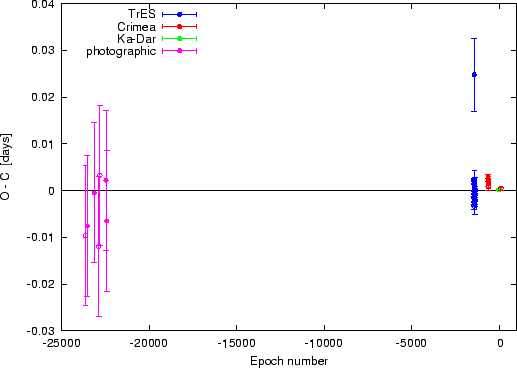 |
Fig. 6
|
2. GSC 2576-02071: a long-period Algol-type binary with an eccentric orbit
GSC 2576-02071 = T-CrB0-03105 = 2MASS 16111795+3307131
(16![]() 11
11![]() 17
17![]() 96 +33
96 +33![]() 07
07![]() 13
13
![]() 2, J2000; Skrutskie et
al. 2006) was discovered as an Algol-type eclipsing binary during
our CCD observations of GSC 2576-01248. After the initial
detection of an eclipse in summer 2006, it took a significant
amount of observing time with a number of telescopes (Table 1) and
the addition of the TrES archival data to accurately determine the
binary's orbital period:
2, J2000; Skrutskie et
al. 2006) was discovered as an Algol-type eclipsing binary during
our CCD observations of GSC 2576-01248. After the initial
detection of an eclipse in summer 2006, it took a significant
amount of observing time with a number of telescopes (Table 1) and
the addition of the TrES archival data to accurately determine the
binary's orbital period:
The archival photographic data provide no additional constrains on the period because of their low accuracy, small variability amplitude of GSC 2576-02071, and lacking photographic data around the primary eclipse. Therefore, only CCD data were used for the period determination. We have employed the same data analysis and period search technique as for GSC 2576-01248 (described in the previous section). The times of minima observed for GSC 2576-02071 are listed in Table 3.
Fig. 7 presents the phased lightcurve of GSC 2576-02071. The
secondary eclipse phase is
![]() , indicating a
significant orbital eccentricity. Additional observations are
desirable to search for signs of an apsidal motion or period
change in this system. The eclipses are partial and last for about
6 hours (Fig. 8). The primary eclipse is
, indicating a
significant orbital eccentricity. Additional observations are
desirable to search for signs of an apsidal motion or period
change in this system. The eclipses are partial and last for about
6 hours (Fig. 8). The primary eclipse is
![]() deep while the
secondary eclipse is
deep while the
secondary eclipse is
![]() deep. The scatter of the
out-of-eclipse lightcurve (excluding the photographic data) is
characterized by
deep. The scatter of the
out-of-eclipse lightcurve (excluding the photographic data) is
characterized by
![]() , which is consistent with the
expected accuracy of the combined multi-instrument CCD dataset.
, which is consistent with the
expected accuracy of the combined multi-instrument CCD dataset.
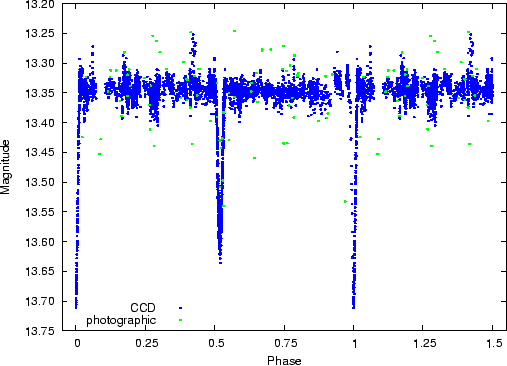 |
Fig. 7.
Lightcurve
of GSC 2576-02071 combining all available CCD (blue) and
photographic (green) photometry phased with the light elements
determined solely from the CCD data:
|
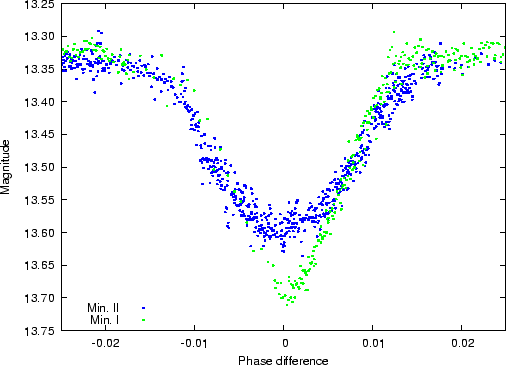 |
Fig. 8. Primary (green) and secondary (blue) minima of GSC 2576-02071 compared. The secondary minimum appears to be about 40 minutes longer then the primary one and is slightly asymmetric with the ascending branch longer then descending. |
3. Conclusions
An initial investigation of two poorly studied eclipsing binary
stars, GSC 2576-02071 (previously unknown) and GSC 2576-01248
(discovered by Devor et al. 2008), based on the archival
photographic and modern CCD data is presented. In the case of
GSC 2576-01248, the addition of photographic observations from
1973-1975 provides a significant improvement in the accuracy of
period determination over the CCD-only dataset obtained in
2005-2007 thanks to the long time baseline between the
observation epochs. Comparison of the archival photographic data
with modern-day CCD photometry also provides an opportunity to
search for possible long-term period changes, which, however, were
not detected for the two binaries described here. The secondary
minimum of GSC 2576-02071 is shifted from the phase ![]() . This
binary system is a promising apsidal-motion candidate.
. This
binary system is a promising apsidal-motion candidate.
Acknowledgments: We are deeply grateful to Jonathan Devor, Francis O'Donovan, Georgi Mandushev, and David Charbonneau of the TrES team for providing their observations of GSC 2576-02071 and GSC 2576-01248. We would like to thank S. V. Nazarov for the opportunity to use CrAO's 24-cm telescope and V. P. Goranskij for providing his lightcurve analysis software. This publication makes use of data products from the Two Micron All Sky Survey, which is a joint project of the UMass/IPAC-Caltech, funded by the NASA and the NSF. This work has made use of the Aladin interactive sky atlas, operated at CDS, Strasbourg, France, the International Variable Star Index (VSX) operated by the AAVSO, and NASA's Astrophysics Data System. K.S. is supported by the International Max-Planck Research School (IMPRS) for Astronomy and Astrophysics at the universities of Bonn and Cologne.
References:
Alonso, R., Brown, T. M., Torres, G, et al., 2004, Astrophys. J., 613, L153
Davidge, T. J., Milone, E. F., 1984, Astrophys. J., Suppl. Ser., 55, 571
Devor, J., Charbonneau, D., O'Donovan, F. T., et al., 2008, Astron. J., 135, 850
Goranskij, V. P., Shugarov, S. Yu., Zharova, A. V., Kroll, P., Barsukova, E. A., 2010, Perem. Zvezdy, 30, 4
Kolesnikova, D. M., Sat, L. A., Sokolovsky, K. V., et al., 2010, Astronomy Reports, 54, 1000
Kwee, K. K., van Woerden, H., 1956, Bull. of the Astron. Inst. of the Netherlands, 12, 327
Lafler, J., Kinman, T. D., 1965, Astrophys. J., Suppl. Ser., 11, 216
O'Connell, D. J. K., 1951, Riverview College Observatory Publ., 2, 85
Skrutskie, M. F., Cutri, R. M., Stiening, R., et al., 2006, Astron. J., 131, 1163
Sokolovsky, K., Lebedev, A., 2005, 12th Young Scientists' Conference on Astronomy and Space Physics, eds.: Simon, A., Golovin, A., Kyiv University Press, p. 79; up-to-date information: cf. http://scan.sai.msu.ru/vast
Sokolovsky, K. V., 2006, Perem. Zvezdy Suppl., 6, 18